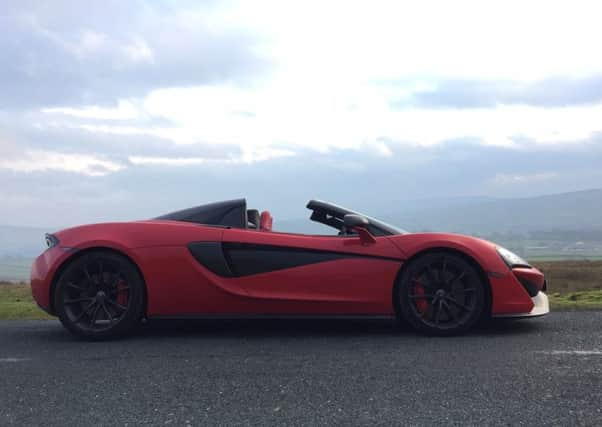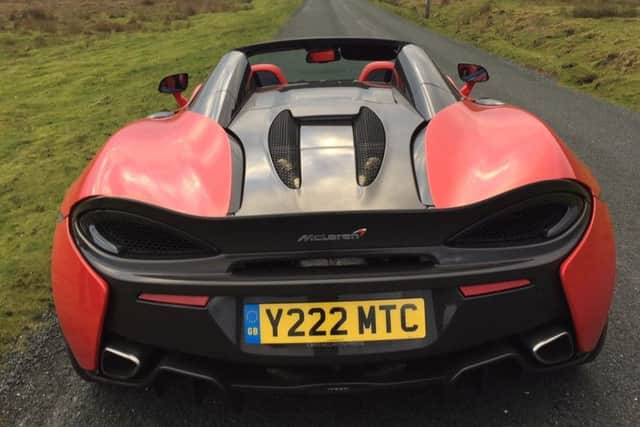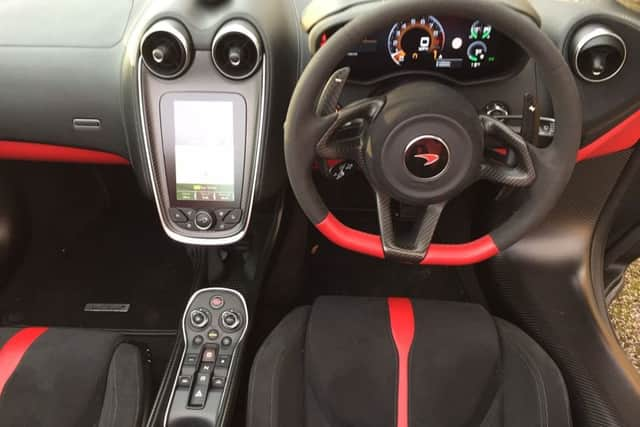Review: McClaren 570S


Few cars attract like a McLaren. It makes stirring noises and looks sensational. “It’s a Lamborghini,” said one tousle-haired urchin. “No, it’s a McLaren,” I answered back. “I call those sort of cars Lamborghinis,” he persisted. Fair enough.
This company with a fine racing pedigree was named after Bruce McLaren, a Le Mans-winning racing driver and designer from New Zealander. He died during testing at Goodwood in 1970. The team and its successors went on to success around the world. Today’s McLaren sports cars are made in Woking, Surrey.
Advertisement
Hide AdAdvertisement
Hide AdThe 570S tested here is one of the cheaper and slower models*, from £164,750. S is for spider, a 19th century English word for an open carriage. An elegant hard-shell roof noisily folds away out of sight behind the seats in 15 seconds. Further back is the 3.8-litre twin turbo petrol V8 engine made by Ricardo of West Sussex, driving the rear wheels through a seven-speed Italian twin clutch automatic gearbox.


McLaren suggests it is an everyday supercar, aware that the fastest Porsche 911 and Audi R8 cars are just that, while the Italian Ferrari and Lambo are not. The Germans are much heavier but all-wheel-drive, putting the McLaren at a disadvantage on slippery surfaces.
The agility of either a young thing or a race driver is useful to enter and leave the car – unless you get the hip and torso movements perfected. The doors swing out and then up vertically, like swan wings. In some ways they are more practical than a conventional side-hinged door. They take up less lateral space but need a few feet extra vertical clearance. It’s not a natural way to open a door and slower than side-hinges. This is one of the features that separate the McLaren from its German rivals. They manage similar performance from a more normal body shape without the overt ducting and spoilers which distinguish a 570S. Discussions rage in the Camshaft Arms about this – but it is the McLaren that gets most bystander attention. Renault’s lightweight and much cheaper Alpine coupé is a contender, as is Honda’s all-wheel-drive hybrid NSX.
An everyday supercar? Just about. There is adequate luggage space under the bonnet, with some more under the rear tonneau cover. It is furnished inside with comfortable, body-gripping heated seats with electric motor adjustment, as is the steering wheel’s rake and reach. Between the seats is a lidded compartment with USB points. Cup-holders and similar pods line up along the central tunnel, with a gloves box to the left. The standard trim material is leather.
Push-buttons select ignition, forward and reverse gears and neutral. Two more switches select the car’s responses, suspension and traction. I left it all in normal, which gives a surprisingly calm, quiet and refined ride. The throttle and brake responses are gentle.


A central, vertical screen displays faultless navigation, plus the audio and heater settings, and so on. The main instrument cluster behind the steering wheel repeats the navigation direction and switches to a camera when reversing. Information includes distance to empty, digital speed and speed limit. A rev counter (red-lined between 8,000 and 9,000 rpm) registers 70mph in seventh gear at 2,000rpm – when the engine is a chuntering rumble.
From the outside the most exciting shapes are at the rear of the car, a composition of air ducts and dynamic channels, and a see-through panel above the engine bay – though you can’t see all that much. The car rides low – a VW Polo alongside seems like an SUV. At the front the chin is vulnerable to even modest road humps but you can pay for a lifter which elevates it at low speed. Its low-slung manner affects good vision, further impaired by the door mirror pods. That’s the deal, for a car which will exceed 200 miles an hour.
Verdict: A superstar with stunning balance and acceleration and a fabulous soundtrack. Easy to drive but fussy entry and exit.
*The 1,035bhp, 250mph hybrid engined Speedtail (£1.75 million plus taxes) covers 0-186mph in 12.8 seconds. All 106 are pre-sold.